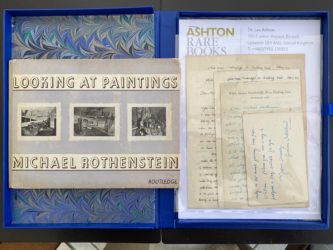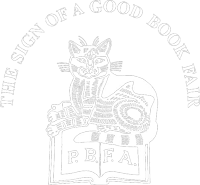
Sutherland, Graham ~ Series Of Eight Unpublished Autographed Letters, One With Small Doodles To Fellow Artist Michael Rothenstein
Graham Sutherland [1903-1980] leading British artist, who began as a printmaker before turning to painting and portraiture, glass and fabrics. A series of eight [8] illuminating unpublished autograph letters, one with small doodles, dating from the 1940's, outlining in some detail his philosophy and practice of art. The letters are all to Michael Rothenstein [1908-1993] artist and printmaker, whose book 'Looking at Paintings' came out in 1947 and featured Graham Sutherland amongst others. In the wake of this publication, I believe Rothenstein may have been considering another book using selective quotes from artists of the day. The letters comprise : 1) 'Autograph letter 2 pages dated Nov 16 1941. 'It was most kind of you to write so appreciatively of my work. So seldom, if at all does one know what sort of effect one's work may have on one's contemporaries. Even if one's work is liked few bother to write - or if they do, seem unable to analyse their reactions - so that you can imagine how grateful I was to get your letter. Doing these war paintings has taught me a lot: but in few of them only do I feel that the problem has been resolved at all completely with that unity of emotion mind & hand. One always hopes to find some day to the equivalent of an easy, smoothly working machine & it may be that the very things which one fights against in one's work are the only things worth preserving!'. He goes on to enquire after Rothenstein's own work and praises an article of Rothenstein's he has read in 'World Revue' '. 2) Autograph letter dated Feb 15th 1942. '..I know precisely what you mean: I've had & in fact still do have very much the same experience, though I think in my own case I can put it down to faulty and insufficient training. I spent from 1928 to 1935 trying to forget what I'd learnt & trying to build on the very narrow ledge which revealed itself!' ...Arranging to meet and telling Rothenstein he is looking forward to seeing his pictures. 3) Autograph 2 page letter dated April 20th 1942. Expressing his disappointment that he has not been able to see Rothenstein due to a bout of pharyngitis. '....Have you seen the work to be shown at the Leicester Galleries under the title of Imaginative Art since the War. With a few exceptions & between ourselves it all struck me as most depressing. This may be a sort of after 'flu' depression. I felt a great deal of dissatisfaction with my own work, except one, & went to the extent of trying to withdraw two of my things. Of course my trouble at the moment is to find any time (& vitality) left after doing war paintings. Being a salaried artist allows me on paper to paint in 'spare' time but one has very little spare time indeed in actual practice & one's conscience prevents me from taking 'ministry' time. One always wants to 'have one's cake and eat it' & occasional yearning for time in which to contemplate fresh themes of ones own is the result.' He goes on to praise what he has seen of Rothenstein's work. 'Looking at the works at the Leicester it came into my mind that scarcely any artist alive can combine largeness & grandeur of pattern with intimacy & continuous profundity who can use decorating forms without being decorative (like Tintoretto did for instance). Forgive this digression, but it seems to me a very important point - or am I wrong? Most English artists seem quite good & often brilliant at pattern - or at creating works which hold a profundity of meaning only when taken out of the portfolio & held to the eye - I'm talking of the best ones too....' . In a postscript he writes 'I did think that your brother's [John Rothenstein, Director of the Tate] collection at the Tate was a revelation, with much that was truly magnificent. I much liked the large Burra...& the Blake's of course gave me the kind of thrill that one gets about once in twenty years.'. Finished with some doodles at the foot of the page. 4) Autograph letter dated May 1942 writing to Rothenstein expressing his regard for the latter's pictures '...What great strides you are making..' 5) Autograph postcard dated May 1943. 'You wrote me on March 11. How horribly barbaric of me not to reply. I've been terribly rushed & fussed & should like to meet you soon....I did so like your article in 'Horizon' on which more later....'. 6) 4 page Autograph letter dated Jan 22 1944. '....The last few weeks have been a terrible rush and grind for me as my last 6 months contracthas been drawing to a close & I have been trying to get a new batch of work finished. The subject was ...coal production...[Sutherland was commissioned by the War Artists Advisory Committee to produce these works on the mines of South Wales around Swansea] Remarkable tho' the subject was, it tended to lack drama which for me is the basis of the opposition of the various units of design. In these coal drawings I've fallen back on the pure element of the structure of ground removed, & the opposition of ground to such things as drag line buckets & scoops. This has probably been good for me& it has enabled me to exploit arbitrary &/or structural use of colour....I don't know the essays of W Lewis [Wyndham Lewis, the artist] to which you refer: but I can't imagining him mentioning my name in any way but an abusive way. I personally admire his painting & always have done; particularly his more abstract efforts. I'm interested in your remarks about war art. The common denominator of a subject is important. On the other hand individual preferences must count I think. Take the crane. It shd be possible to render this mechanical object as a unit of design of purely formal value or, as a means of transference of action from one thing, (the crane) to another which it picks up. Its always been a favourite object with topographical artists from Brangwyn to Bone & a host of others & perhaps it is because one associates it with this type of art that it is difficult....on the Cezanne principle that subject doesn't matter a damn it shd be possible to manage it. But I think subject does matter: & if not one subject why not all. Answer (?) Particular subjects must appeal to individuals & to certain rythms [sic] in their internal make up. I'm drawn to certain subjects very strongly Because I'm more interested in the reality which is just underneath their physical reality & can feel it. I like looking at a chest of drawers & suddenly being conscious of its unknown reality out of the edge of my mind. Therefore as I can see landscape (& figures perhaps in relation to it) more clearly in this way I shall always be eager to divest myself of this feeling:obscure though it is. This is all very woolly: I, too have had flu...& that's probably why I can't properly express myself.' 7) 4 page autograph letter undated but c. 1947 since Sutherland refers to a 'typescript' presumably of Rothenstein's book published that year. '...What you have written I like & it has something to do with what I try to do. BUT why? oh why must the sins of war time semi journalism be harped on? The pictures that I did then, of course, have something in them. The subject was often too exciting to go entirely wrong. But every picture was of necessity a partial compsomise because while trying to remain true to oneself & ones vision one had the very real duty to report & describe as well as to paraphrase and synthesize. Pity you didn't use something earlier or more recent - like the large thorn picture I had at Lefevre's [gallery]: one of the few pictures I have painted of which I'm not ashamed - or rather of which I'm less ashamed than of some. At least here, for better or worse, I was doing what I wanted with my eyes and mind entirely free. Still, there it is. I think your technical notes are O.K. but the war method is somewhat different than peace time pictures & more systemized. 1. pencil drawings & notes..on the backs of envelopes or a rough note book....2. Innumerable drawings generally in colour in crayon & paint & ink. Done in sketch book trying to find the symbol & to design. Trying to find a way between reporting and description of the subject & the creation of forms through feeling. 3. The Final painting Now in peace, (or something approaching it.) I don't have to worry about this question at all. All I have to worry about is whether the forms I create from feeling can be related and balanced in such a way that they lead a permanent life of their own & retain their tension inherent in the feeling of the real thing.'He goes on to ask after Rothenstein's own paintings 'The last ones I thought a great advance....'. 8) Autograph postcard dated July 8th 1948 offering to meet to discuss Rothenstein's proposed book. The letters are all in Very Good++ condition with a little toning and a hint of creasing to some of the page edges. A First UK edition copy of Rothenstein's 'Looking at Paintings' published by Routledge in 1947 also accompanies these letters. The BOOK is in Very Good++ condition with one previous owner's inscription to the upper front blank-endpaper. An illuminating series of letters between two great artists of the 1940's and 50s'. The letters are housed in a transparent archival folder within a custom solander box with marbled inserts, silk tie and silver lettering.
LETTERS: Loose
CONDITION: Very Good++
£3750



